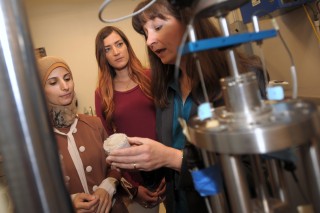Nov 4 2015
NMSU researchers work to solve infrastructure challenges, members of new Engineering Research Center.
 NMSU civil engineering professor Paola Bandini, right, works in her laboratory with graduate students Hend Hussien Al-Shatnawi, left, and Rachelle Mason. Bandini was honored at the NMSU Scholarly Excellence Rally Oct. 30. (Photo by Darren Phillips)
NMSU civil engineering professor Paola Bandini, right, works in her laboratory with graduate students Hend Hussien Al-Shatnawi, left, and Rachelle Mason. Bandini was honored at the NMSU Scholarly Excellence Rally Oct. 30. (Photo by Darren Phillips)
Newswise — In August, New Mexico State University was announced as one of four universities in a new National Science Foundation Engineering Research Center to develop advances in geotechnical engineering that will provide solutions to some of the world’s biggest infrastructure development and environmental challenges.
NMSU’s College of Engineering joins a consortium of university, industry and government partners, led by Arizona State University. The $18.5 million NSF award establishes the Center for Bio-mediated and Bio-inspired Geotechnics (CBBG) to expand the emerging field of biogeotechnical engineering.
Paola Bandini, NMSU civil engineering associate professor, CBBG co-principal investigator and leader of the center’s work at NMSU, was honored at NMSU’s Scholarly Excellence Rally Friday, Oct. 30. She is directing the center’s work on infrastructure construction, one of four research thrusts of the program.
Engineers and scientists at NMSU, ASU, Georgia Tech and the University of California, Davis are collaborating to develop methods to use or mimic biological processes for engineering the ground in ways that reduce construction costs while mitigating natural hazards and environmental degradation.
“The Center for Bio-mediated and Bio-inspired Geotechnics will learn from nature,” Bandini said. “We will learn from biological processes. Nature has had 3.8 billion years of evolution to develop and perfect, very elegant, efficient solutions to problems.
“We’re going to learn from those biological processes to improve the methods and find solutions for infrastructure-related construction, maintenance and operations; to reduce the carbon footprint of our construction methods; to reduce the ecological and environmental impact of industries like mining and construction; and to make better and more sustainable use of the non-renewable resources we have,” she said.
The center’s four research thrusts include hazard mitigation, environmental protection and restoration, infrastructure construction and resource development.
The second main objective of the center is to inspire a diverse group of engineers and scientists to provide the associate workforce necessary for this new field of biogeotechnical engineering.
“In addition to the university partnership, we have education, outreach and diversity partners including community colleges, school districts and science museums that will work with us to deliver the educational materials that we will develop through the center,” Bandini said. “The CBBG also includes a strong partnership program with private industry and government agencies like state departments of transportation, cities and counties that are owners and managers of the civil infrastructure.”
The center has more than 12 companies and state government agencies confirmed as industrial partners to support the research initiatives along with 15 universities from across the globe.
A multidisciplinary team of nine NMSU researchers specialized in civil engineering, geotechnical and environmental engineering, computer science, geological sciences and biology will participate in various CBBG projects.
In the first year, NMSU research projects will include bio-inspired soil reinforcement, a study of the mechanisms of root growth and mechanical reinforcement in unsaturated soil; bio-enhanced removal of contaminants in groundwater; revegetation of degraded top soils, stripped lands or salinized and eroded soils; and development of self-motile probe for multi-sensor deployment for subsurface investigations.
In addition, NMSU’s Arrowhead Center will help implement technology transfer and pursue patents for technologies created at NMSU through CBBG’s research.
The NSF award will fund the center for five years. NSF support can be continued for an additional five years; following that period the center is expected to become self-supporting.